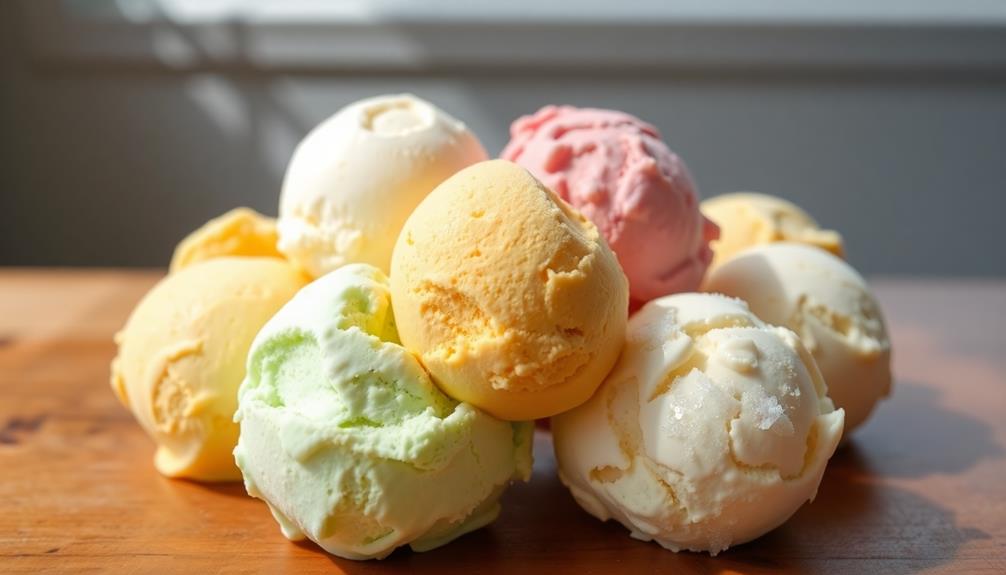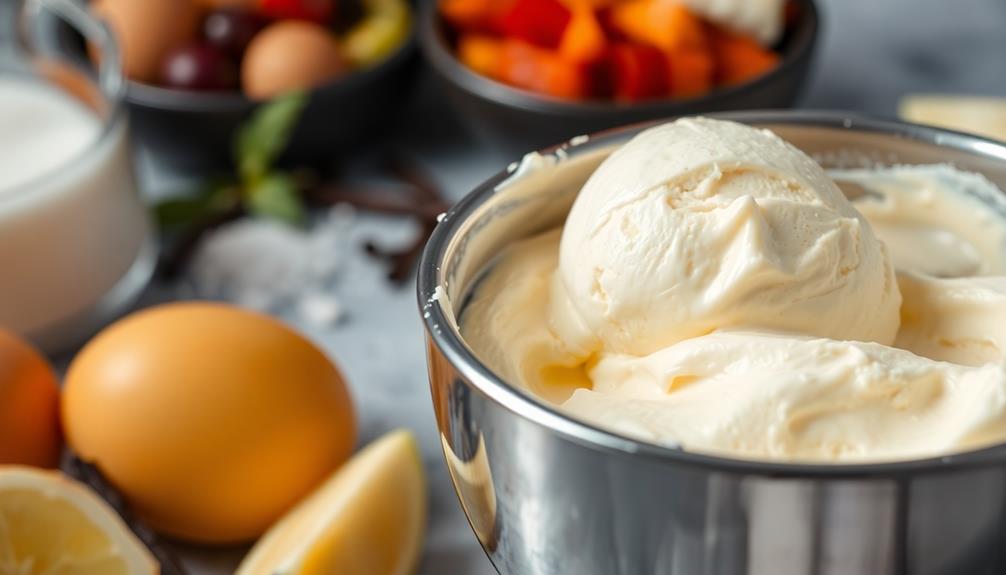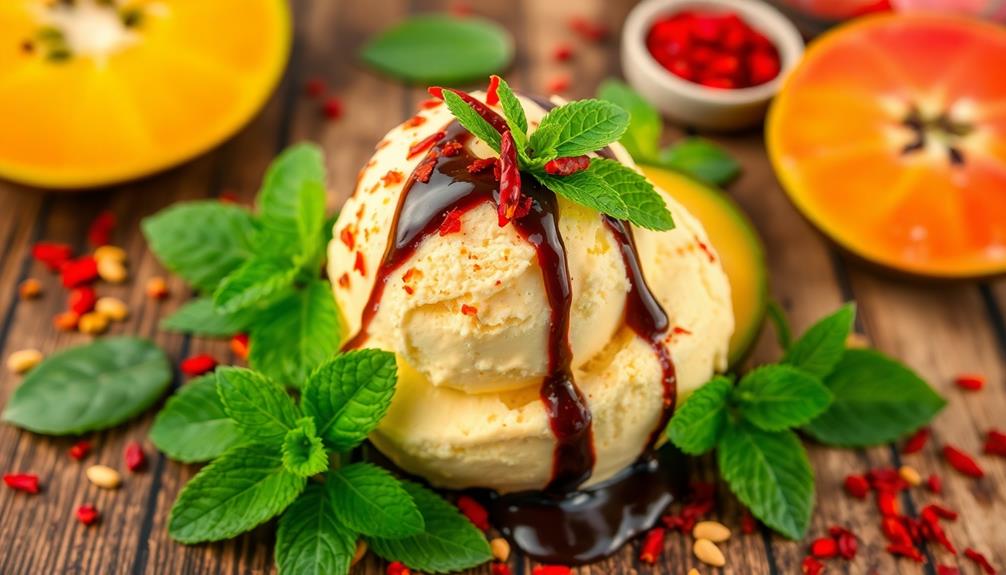Different sweeteners greatly impact your ice cream's consistency. Sucrose provides foundational sweetness and controls ice crystal size, while corn syrup solids help maintain a smoother texture. Lower molecular weight sweeteners like dextrose and fructose depress the freezing point, making your ice cream creamier and easier to scoop. Too much sweetness can mask flavors, so it's important to balance sweeteners for a harmonious taste. High fructose corn syrup results in a softer texture that melts faster. Understanding how these sweeteners work together can profoundly influence your ice cream experience, and there's more to discover about this sweet science.
Key Takeaways
- Different sweeteners impact the freezing point; lower molecular weight sweeteners like dextrose and fructose create softer, scoopable ice cream.
- The total solids content, influenced by sweeteners, reduces ice crystal size, resulting in a creamier texture.
- Sweetener viscosity affects the thickness and mouthfeel of ice cream, contributing to overall consistency.
- A balance of sucrose and HFCS optimizes sweetness while maintaining desirable texture and preventing excessive sweetness.
- Higher sweetness levels can lead to quicker melting rates, affecting the overall experience of ice cream.
Types of Sweeteners in Ice Cream
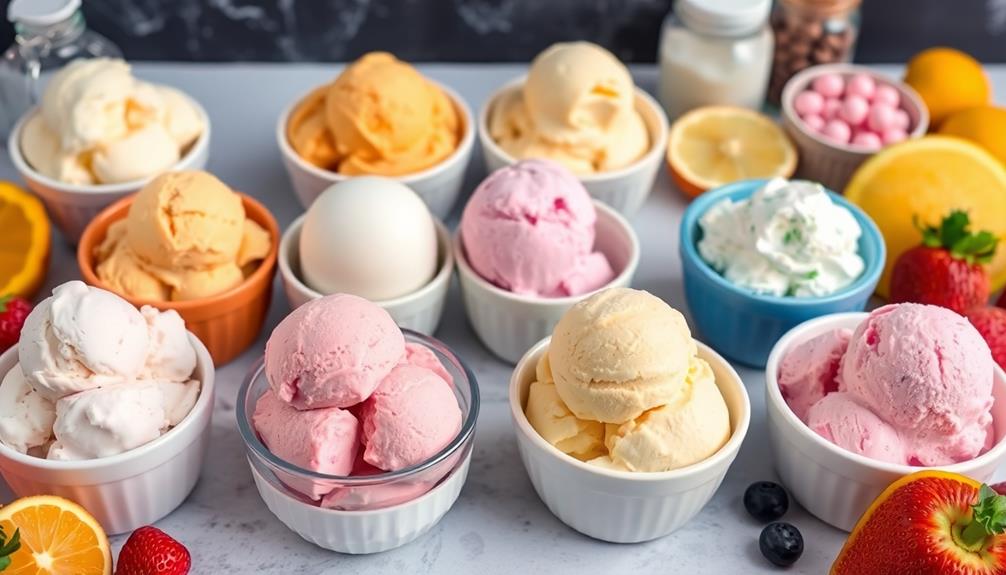
When it comes to crafting the perfect ice cream, the choice of sweeteners plays an important role in achieving the right balance of flavor and texture. You'll typically find a combination of sweeteners like sucrose and corn syrup solids in your favorite ice cream. Sucrose, making up about 10-12%, provides a foundational sweetness, while corn syrup solids (CSS) contribute an additional 3-5%.
Fructose, the sweetest common sweetener, can elevate flavor perception when used sparingly. Incorporating lower molecular weight sweeteners like dextrose and fructose also lowers the freezing point, enhancing texture and scoopability. This is essential for getting that creamy consistency you love.
Moreover, the balance of sweeteners directly impacts the total solids content in your ice cream. Higher total solids lead to smaller ice crystals, which create a smoother, creamier product.
However, be cautious: too much sweetness can overwhelm other flavors and create undesirable textures. Conversely, not enough sugar can result in an overly hard product. So, understanding the types of sweeteners you use is critical for that perfect scoop of ice cream.
Sweetness and Flavor Dynamics
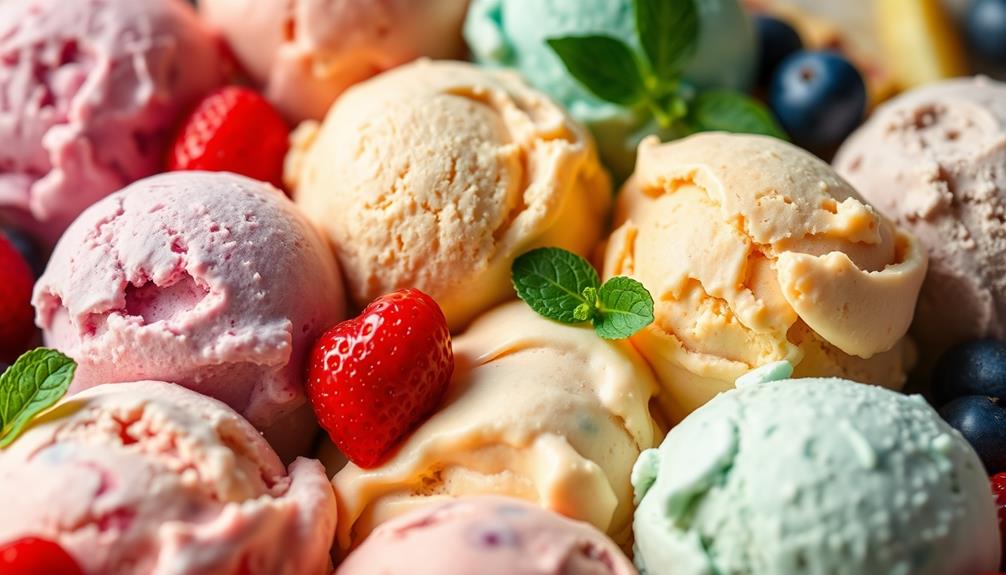
When you think about sweetness in ice cream, remember that not all sweeteners hit the same mark.
Some can easily overpower other flavors, while others might leave your creation tasting flat.
It's essential to understand how different sweetener profiles interact to create a balanced and enjoyable flavor experience.
Sweetness Perception Variability
How do sweeteners affect your perception of flavor in ice cream? The choice of sweeteners directly impacts your sensory experience, with their relative sweetness playing a significant role.
For instance, fructose is much sweeter than sucrose, which can lead to excessive sweetness if used alone. This overwhelming sweetness may mask other flavors, resulting in a flat taste profile.
In ice cream formulations, sweetener blends are vital for achieving a balanced flavor profile. Using a mix of sweeteners can slow the sweetness development, as seen with sucrose, enhancing other flavor notes and creating a more complex taste.
This balance is essential, as sweetness perception variability influences consumer preferences.
When done right, sweeteners not only add sweetness but also elevate the flavor of fruits and spices, leading to an overall enhanced flavor experience.
The key is to avoid excessive sweetness that could detract from the intricate flavors you expect in ice cream. By understanding how different sweeteners interact, you can enjoy a richer, more satisfying ice cream that aligns with your taste preferences.
Flavor Masking Risks
Excessive sweeteners in ice cream can lead to significant flavor masking risks, diminishing the overall tasting experience. When you use sweeteners like sucrose, their slow sweetness development might make the flavors of dairy and other ingredients feel flat if not balanced well. High fructose corn syrup (HFCS) can also contribute to flavor masking, especially since it's sweeter than sucrose. If you don't find the right balance, you could end up with a less complex flavor profile.
Here's a quick look at how different sweeteners can impact flavor:
| Sweetener Type | Flavor Impact |
|---|---|
| Sucrose | Slow sweetness; may mask flavors |
| High Fructose Corn Syrup | Enhances sweetness; can overpower flavors |
| Fructose | High sweetness; risks one-dimensional taste |
| Stevia | Natural sweetness; potential bitterness |
| Erythritol | Mild sweetness; less flavor masking risk |
When sweeteners like fructose are used excessively, they can overwhelm the other flavors, reducing the complexity you want in your ice cream. So, always consider the concentration and type of sweeteners to maintain a harmonious flavor balance.
Unique Sweetener Profiles
Balancing sweetness is key to achieving the perfect ice cream consistency, and understanding unique sweetener profiles helps in that quest. Different sweeteners rank in sweetness, with fructose at the top, offering a robust flavor punch at 173 on the sweetness scale. In contrast, sugar and sweetener blends like high fructose corn syrup (HFCS) provide a more balanced sweetness while enhancing the overall flavor profile.
Using too much sucrose can mask other flavors due to its slower sweetness development, so combining it with sweeter alternatives like invert sugar can improve the texture of ice cream. Invert sugar not only prevents crystallization but also contributes to a smooth mouthfeel, essential for enjoyable ice cream.
Moreover, sweeteners like dextrose and fructose lower the freezing point more effectively than sucrose, resulting in softer ice cream that enhances scoopability.
This balance of sweetness and texture is vital in creating ice cream that delights consumers. By leveraging the unique profiles of these sweeteners, you can achieve an ice cream consistency that's both flavorful and satisfying.
Texture and Ice Crystal Control
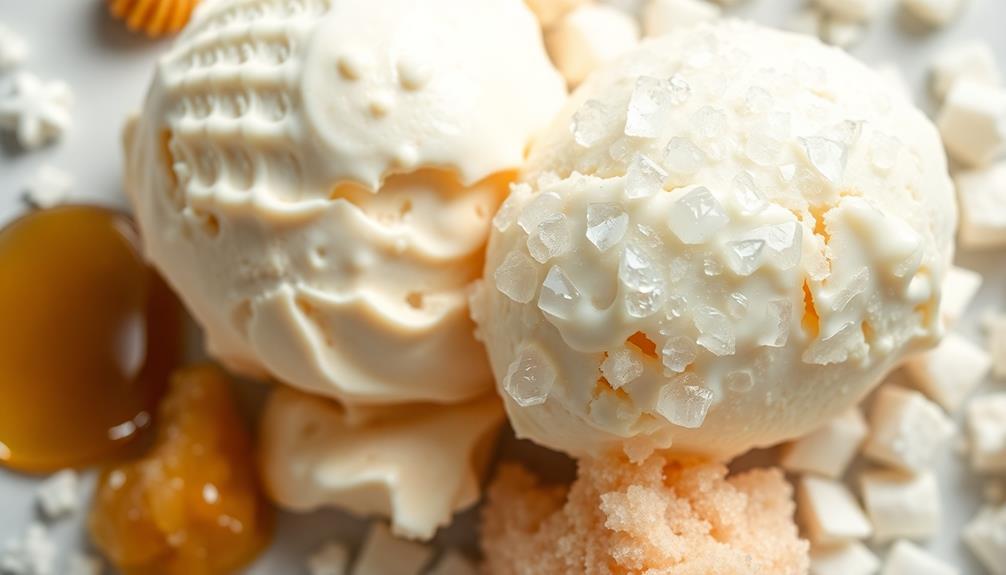
When you choose the right sweeteners for your ice cream, you're directly impacting ice crystal size and texture.
Higher levels of sweeteners not only create smaller ice crystals but also enhance the mix's viscosity, leading to a smoother mouthfeel.
Understanding these effects can help you craft a creamier, more enjoyable ice cream experience.
Ice Crystal Size
Ice crystal size plays a pivotal role in determining the texture of ice cream. The type and concentration of sweeteners you choose greatly influence this size.
When you increase the total solids content from sweeteners, you promote the formation of smaller ice crystals, leading to a smoother texture in your ice cream.
Sweeteners like sucrose and high fructose corn syrup (HFCS) lower the freezing point of the ice cream mix, effectively reducing the growth rate of ice crystals during freezing.
Sweetener Viscosity Effects
The viscosity of sweeteners is fundamental for achieving the perfect texture in ice cream. When you use sweetener blends with higher concentrations, you increase thickness, which helps control ice crystal growth during freezing.
Different sweeteners affect viscosity uniquely; for instance, high maltose syrup and invert sugar enhance viscosity more than sucrose due to their molecular structures. This property is essential for ensuring a smooth mouthfeel.
Additionally, sweeteners like dextrose and fructose effectively lower the freezing point compared to sucrose, resulting in smaller ice crystals that contribute to a creamier texture. By increasing the total solids content through various sweeteners, you can further reduce ice crystal size, enhancing the overall creaminess of your ice cream.
However, balance is critical. Too much sugar can lead to a soggy texture, while ideal ratios of sweeteners maintain the desired viscosity and prevent large ice crystal formation.
Ultimately, understanding how sweeteners affect viscosity will empower you to create ice cream with the perfect texture and delightful mouthfeel.
Freezing Point and Softness
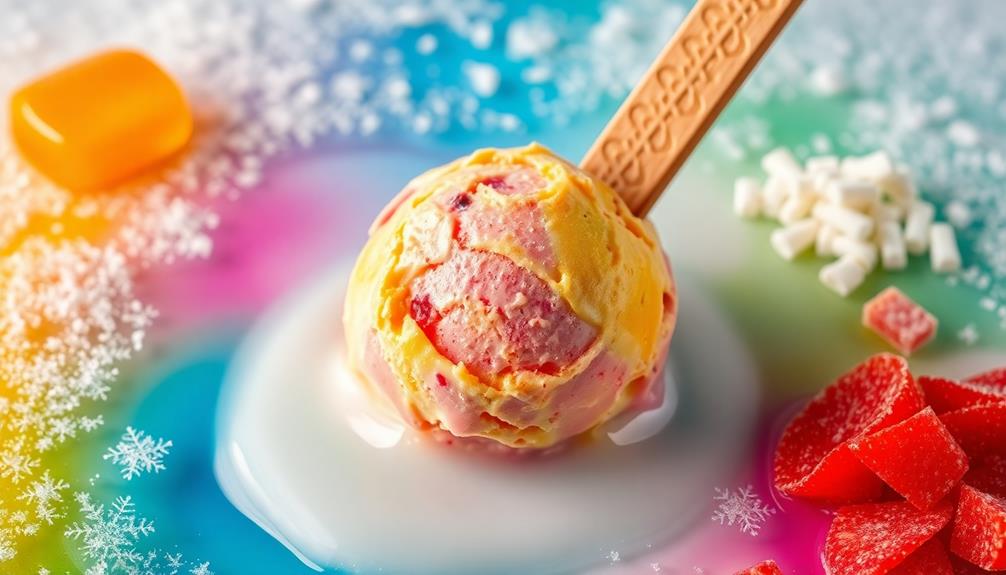
How do sweeteners influence the texture of your favorite frozen treat? The type and amount of sweeteners you use can greatly affect ice cream's freezing point and softness.
Sweeteners like dextrose and fructose have a lower molecular weight, leading to greater freezing point depression compared to traditional sucrose. This means your ice cream stays softer and creamier, making it easier to scoop.
For example, high fructose corn syrup (HFCS) can depress the freezing point by about -4.4°C. As you increase the concentration of sweeteners, you lower the freezing point even further, resulting in a softer texture.
Ice cream with higher total solids content, which includes these sweeteners, usually has smaller ice crystals, enhancing its creaminess and smooth mouthfeel.
However, balance is essential. If you add too many sweeteners, your ice cream may become overly soft, losing its structure when served.
Impact on Melting Rate
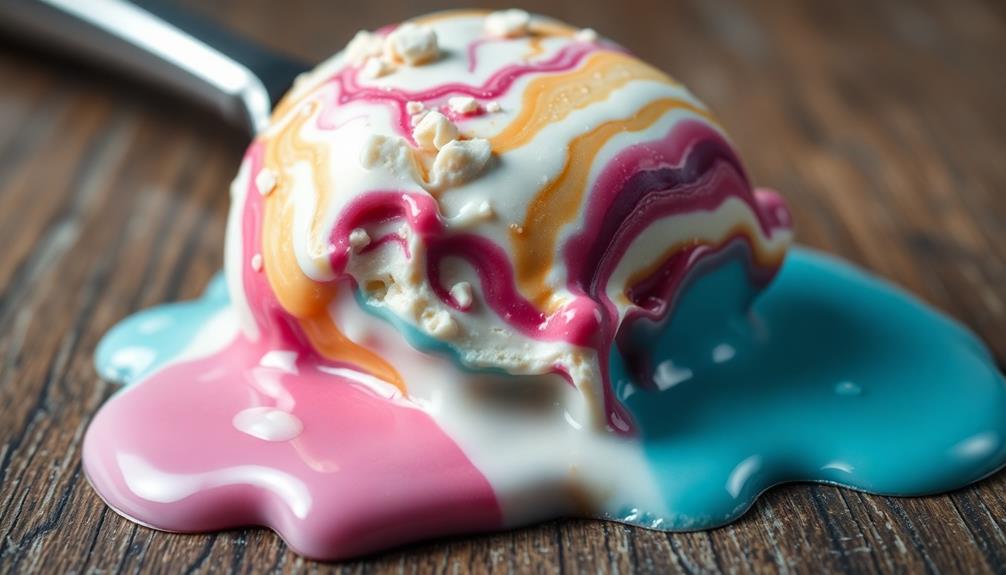
Understanding how sweeteners affect melting rates can help you make better choices for your homemade ice cream. The type of sweetener you use plays a significant role in the melting rate. For instance, sweeteners like high fructose corn syrup (HFCS) create a greater freezing point depression of -4.4°C, leading to a softer texture and quicker melting. In contrast, sweetener blends with 20 DE corn syrup solids maintain a higher freezing point of -1.7°C, resulting in a firmer texture and slower melting rate.
Here's a quick comparison of various sweeteners and their impact on melting rates:
| Sweetener Type | Melting Rate Effects |
|---|---|
| High Fructose Corn Syrup | Softer, quicker melting |
| Dextrose/Fructose | Faster melting due to low molecular weight |
| 20 DE Corn Syrup Solids | Slower melting, firmer texture |
| Increased Sugar Content | Higher melting rate, softer consistency |
The overall sugar content and total solids also influence the size of ice crystals, further affecting your ice cream's consistency and melting behavior. By understanding these factors, you can create the perfect treat for your taste!
Balancing Sweeteners for Quality
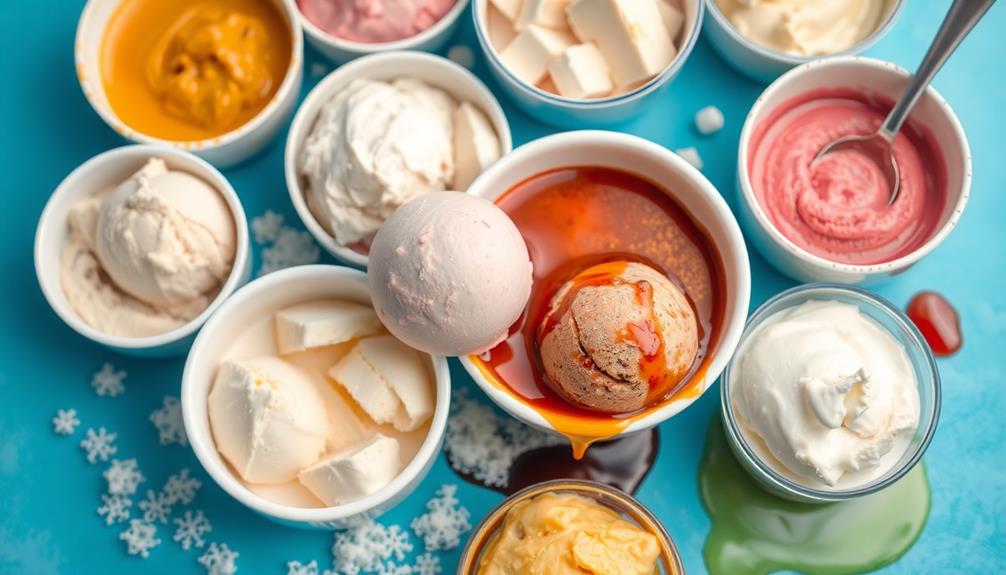
Achieving the perfect balance of sweeteners in ice cream formulation is vital for enhancing flavor and texture. When you use a typical combination of sucrose (10-12%) and high fructose corn syrup (3-5%), you boost sweetness without overpowering the other flavors. This careful balance helps maintain your desired flavor profile while optimizing total solids content.
Higher total solids lead to smaller ice crystals, which improve texture and create a creamier mouthfeel.
Consider incorporating sweeteners like dextrose and fructose, as they lower the freezing point more effectively than sucrose. This not only contributes to a softer texture but also enhances scoopability.
However, be cautious; excessive use of sweeteners can mask the natural flavors of your ice cream. It's important to adjust the sweeteners carefully to maintain a balanced flavor profile.
Using different sweeteners strategically, like invert sugar, can also help achieve the desired sweetness levels while enhancing texture and consistency.
Frequently Asked Questions
What Determines the Consistency of Ice Cream?
The consistency of ice cream's determined by total solids content, including fat and milk solids. Higher total solids create a creamier texture, while the right balance of ingredients guarantees a smooth, enjoyable experience when you scoop.
What Are the Factors Affecting the Texture of Ice Cream?
Did you know that ice cream typically contains 30-40% air? Factors affecting texture include fat content, ingredient balance, and incorporation of air during churning. Each element plays a vital role in achieving that perfect creaminess.
How Does Sugar Affect the Texture of Ice Cream?
Sugar plays an essential role in your ice cream's texture. It enhances body and firmness, reduces ice crystal size, and affects the freezing point, resulting in a smoother, creamier scoop that's easier to enjoy.
What Are the Three Ingredients That Affect the Texture of Frozen Ice Cream?
Imagine a creamy scoop of ice cream melting in your mouth. Three key ingredients shape that texture: sugars, fats, and stabilizers. Each plays a role in achieving the perfect balance of smoothness and richness.
Conclusion
When it comes to crafting the perfect ice cream, the choice of sweeteners can make or break your frozen masterpiece. You've got to balance sweetness, texture, and melting rates to achieve that creamy perfection. The right sweetener can elevate your ice cream from a simple treat to a euphoric indulgence that'll make your taste buds dance like they've won the lottery. So, next time you're in the kitchen, remember: sweeteners are the unsung heroes of your ice cream adventure!
